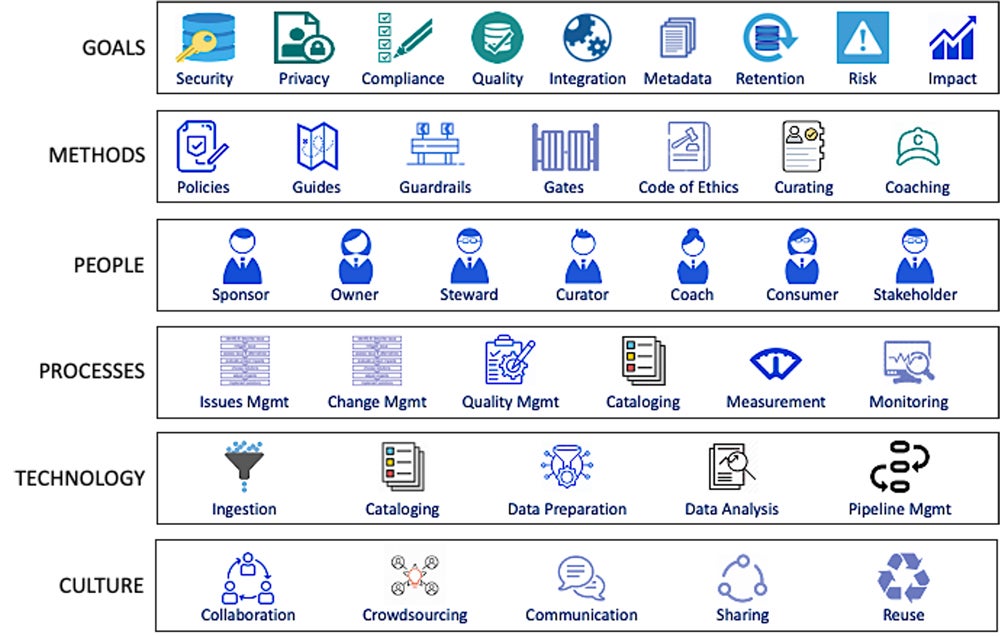Data governance frameworks are structured approaches to managing and utilizing data in an organization. They include policies, procedures, and standards that guide how data is collected, stored, managed, and used. These frameworks help with quality, integration, privacy and security, and effective architecture.
Organizations are collecting and storing more data than ever before. This data can be used to improve business processes, but it can also be a liability if mishandled. The frameworks have, therefore, become an invaluable way to protect the privacy of their customers and comply with the latest privacy laws. However, organizations must implement a framework that goes beyond basic quality and management.
To govern data effectively, organizations need to have a clear understanding of their landscape. They need to know where their data comes from, who owns it, how it’s being used, and where it’s stored. Gathering this information to build a framework requires close collaboration between different departments and business units.
SEE: What Is Data Quality? (TechRepublic)
How data governance frameworks work
It’s not just about following the law or managing risk, it’s about effectively harnessing the power of data to drive decision-making, innovation, and competitive advantage.
The primary purpose of implementing a framework is to come up with a systematic approach to managing data across its entire lifecycle. This means setting internal standards and policies, defining ownership and stewardship, and formulating processes for quality management, security, compliance, and privacy. The end goal is to create an in-house culture where data is treated like a critical business asset.
Examples of data governance frameworks
Below is a list of some commonly referenced frameworks:
Each of these frameworks has its own pros and cons. Organizations should select the one that aligns with their unique needs and goals.

SEE: Data Governance Checklist (TechRepublic Premium)
Types of data governance frameworks
There are two opposing philosophies to creating frameworks that offer different pros and cons depending on an organization’s specific objectives.
Bottom-up philosophy
The bottom-up approach, popularized by the big data movement, begins with raw data. It is first ingested, then structures or schemas are built on top of the data once it has been read. Governance rules, policies, and quality controls are also added to the dataset at this time.
The advantage of this approach is its scalability. However, it can be difficult to maintain consistent quality control across a large volume of data.
Top-down philosophy
In the top-down approach, data modeling and governance take priority and are the first steps in developing a framework. The process begins with data professionals applying well-defined methodologies and best practices. The advantage of this approach is its focus on quality control.
SEE: How to Measure Data Quality (TechRepublic)
Components of a data governance framework
There are four primary components:
- Data stewardship: The stewards ensure an organization’s data assets are accurate, consistent, and compliant with all relevant regulations, especially over the course of company projects.
- Data quality management: This includes processes and procedures used to ensure an organization’s data assets are free from errors and inaccuracies, as well as methods for identifying and correcting any errors or inaccuracies.
- Data management: The processes define how an organization’s data assets are created, stored, accessed, and used. They also establish the rules for how those assets will be shared with internal and external stakeholders.
- Technology infrastructure: This refers to the hardware and software systems used to collect, store, and manage data. These include databases, enterprise resource planning systems, data warehouses, and network connections that facilitate the exchange of information between stakeholders.
SEE: Best Practices to Improve Data Quality (TechRepublic)
Pillars of data governance frameworks
The frameworks are built on four key pillars that ensure the effective management and use of data across an organization. These pillars ensure data is accurate, can be effectively combined from different sources, is protected and used in compliance with laws and regulations, and is stored and managed in a way that meets the needs of the organization.
1. Data quality
Data quality is the cornerstone of any framework. It ensures the data used in decision-making processes is accurate, consistent, and reliable. Further, quality management involves establishing policies and procedures for validation, cleansing, and profiling.
2. Data integration
Data integration involves the combination of data from different sources using various tools to provide a unified view. This pillar ensures that data from various departments, business units, or external partners can be effectively merged and used for analysis and decision-making.
3. Data privacy and security
Data privacy and security involve the implementation of policies and procedures to protect sensitive data and comply with data protection laws and regulations. This pillar includes encryption, access control, and anonymization techniques.
4. Data architecture
Data architecture refers to the design and structure of systems. This includes the design of databases, data warehouses, and data lakes.
SEE: What Is Data Science? (TechRepublic)
Why is a data governance framework necessary?
We can identify three main reasons:
- Keep a standard set of policies and procedures: Without such a framework, critical data assets are at risk of becoming fragmented, inaccurate, and non-compliant with relevant regulations.
- Prevent rudderless effort: A lack of governance can lead to confusion and duplication of effort, as different departments or individual users try to manage data with their own methods.
- Regulatory compliance: A framework ensures compliance with various laws and regulations, such as HIPAA and GDPR.
SEE: How to Balance Data Storage, Features, and Cost in Security Applications (TechRepublic Premium)
Best practices for creating a data governance framework
The first step to creating an effective framework begins with a clear understanding of the organization’s goals and the role proper data management plays in achieving them.
It is also advisable to focus on simplicity and flexibility when developing a framework. Many unnecessary rules can hinder adoption, while flexibility (without compromising security and compliance) ensures quick adaptation to a changing business or regulatory environment.
Involve stakeholders in a continuous dialogue to refine data governance practices when they become outdated. Finally, you must invest in the right data governance tools to optimize your operations.
This article was originally published in September 2022. Updates were made by the current author in July 2023 and April 2024. The latest update was by Antony Peyton in June 2025.

